Are you a Fuchsia fan? Do you like to share plants and cuttings? As Autumn winds and cooler temps hit my part of the UK, Autumn scenes bring vibrant colour to the landscape. As I look out my window tree branches are becoming barer by the hour.
In our gardens Fuchsias are also well known for their vibrant colours but perhaps not as well known is the fuchsia gall mite, Aculops fuchsiae. As a gardener, an email from the RHS this morning entitled ‘Beware of Friends Bearing Gifts’ caught my attention. If you are a Fuchsia fan, the image below needs to catch your attention.
Not being a Fuchsia fan I had no photos for this post. I contacted the RHS and was kindly sent the photo above showing what fuchsia gall mite looks like next to a healthy plant. The first thing to notice is that it is the shoot tips that is affected. Eventually all new growth stops developing.
Autumnal scenes from a walk at the Hermitage yesterday were to be my planned posting for today. It is quite a magical spot. Below, you will see what caught my eye dispersed through info from the email I received from the RHS this morning.
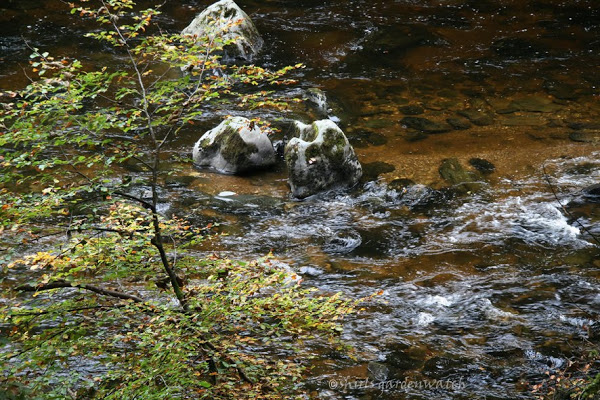
“Because of the risk of spreading fuchsia gall mite, Aculops fuchsiae, the Royal Horticultural Society (RHS) is warning gardeners to be careful about sharing fuchsia plants and cuttings.
The mite was first detected in the UK by the RHS only three years ago when one of its members in Hampshire sent a sample of severely distorted growth on a fuchsia to the RHS members’ advisory service for diagnosis.
Since then other samples of mite-infested fuchsias have been sent in every year and the mite is known to be widely distributed in Southern England from Kent to Devon.”
““This is a devastating pest because it destroys the plant’s shoot tips and flowers. None of the pesticides available to gardeners will control it,” says Andrew Halstead, RHS Principal Entomologist.
“Although the detection of fuchsia gall mite has to be notified to the Plant Health and Seeds Inspectorate at FERA (Food and Environment Research Agency) they are not taking any action on plants in private gardens. We anticipate that infestations across the country will increase significantly in the next few years.” “
“There is little that gardeners can do about this pest except destroy infested plants to prevent the mites spreading to other fuchsias.
Late summer and autumn are good times to look for infested plants as gall mite damage should be obvious by then if the pest is present.
In spring, vigorous new growth may mask the presence of the mites, particularly as they are likely to be present in lower numbers at that time of year.”
“The mite is microscopic and so is easily spread by the wind. It is also likely that bees visiting flowers on infested plants will pick up and transfer mites in a similar manner to pollen grains.
So if one plant has become infested it is likely that other fuchsias in the garden may be as well.
Symptoms of infestation develop gradually. Usually a reddening of the leaves is first noticed, especially at the shoot tips. As the mite numbers increase leaves, flowers and the shoot tips become deformed and swollen. Finally all new growth stops developing.”
“Normally the RHS only provides its free diagnostic service to its members. However, because of the charity’s concern about the spread of this relatively new pest and the damage it does it has opened the service to non members who believe they might have an infested fuchsia plant.
Gardeners, therefore, who suspect they may have fuchsia gall mite can send or bring samples of affected shoots in sealed polythene bags to:
Gardening Advice,
RHS Garden,
Wisley,
Woking,
Surrey,
GU23 6QB.
Digital images of damaged plants can also be sent to gardeningadvice@rhs.org.uk.”
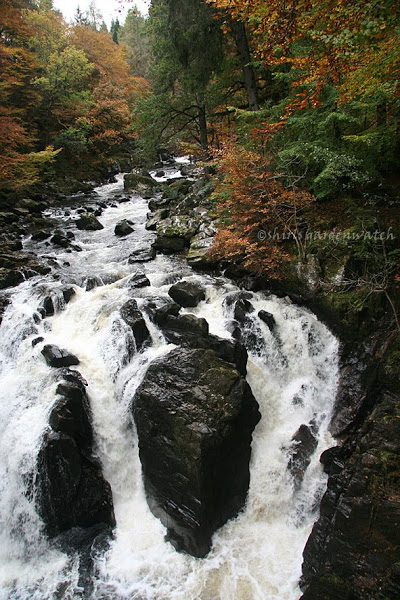 Black Linn waterfall, view from Ossian’s Hall.
Black Linn waterfall, view from Ossian’s Hall.
“The charity advises that fuchsia leaves that are misshapen with many small holes, but are green and of normal thickness, have been damaged by capsid bugs.
Fuchsia gall mite causes thickening and severe distortion of the foliage, which may be reddish pink or yellowish brown.”
““Fuchsias are popular garden plants because of their long flowering period in mid – late summer,” says Andrew. “As this pest becomes more widespread I anticipate that their popularity will go into sharp decline. Apart from losing the showy colours they add to our gardens we may also lose the spectacular hedgerows of fuchsias in Cornwall and Devon.”
“The RHS recommends that any plants showing symptoms of infestation should be dug up and burnt or buried, as there are currently no other effective control measures available for use in gardens.
Neighbours should be encouraged to do the same.
The charity also suggests leaving a gap of a year before trying to grow replacement fuchsias. Fuchsias in garden centres and any cuttings or plants offered by friends should be checked carefully and rejected if there are any signs of distorted growth.”
Chatting to Eoin at the RHS this morning, we also discussed the Horse chestnut leaf-mining moth. If you have been watching Autumnwatch you may have heard them discussing the condition of the leaves on our conker trees .
Sightings of Horse chestnut trees (conker trees) with affected leaves can be submited through the Autumnwatch website. You might be interested in the short video about it below. You can read what the RHS are saying about them here.
Finally, amidst all the warning info I hope you’ve enjoyed some Autumnal scenes. There is a serious chill in the air here tonight. Not here, but on higher ground in Scotland I’ve even heard snow forecasted for later on in the week.
Out on our walk through the cathedral-like atmosphere of the Hermitage yesterday it was ‘snowing’ leaves and pine needles at times. It really was quite magical. Hard as I tried I couldn’t capture that with my camera.
So, it’s good-bye to green leaves and hello again to wonderful rich green mosses. It’s also time to look out gloves and hats. Happy Autumn 🙂
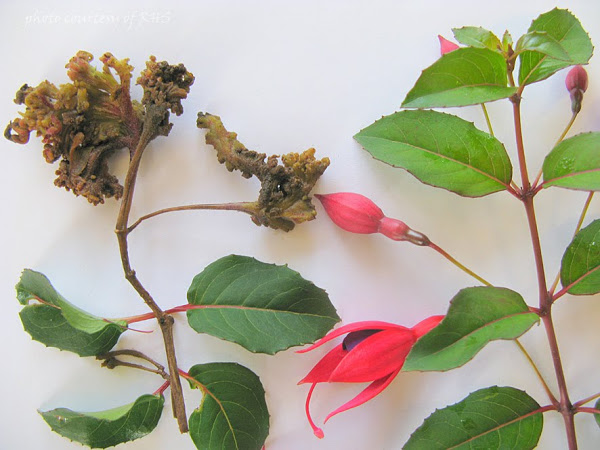
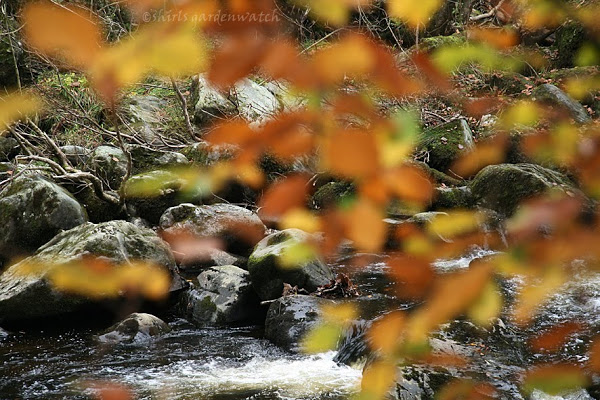
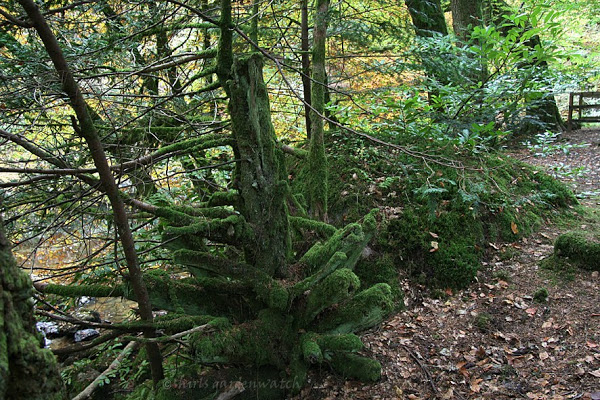
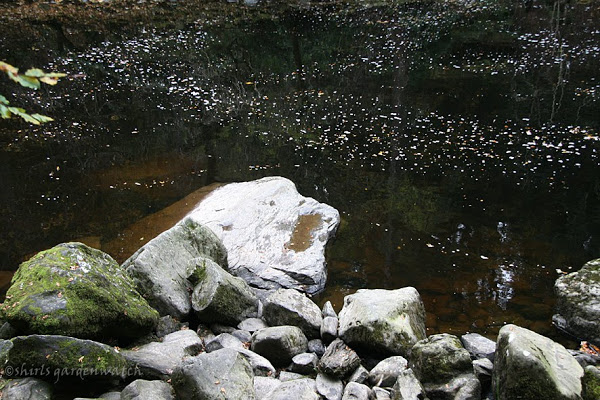
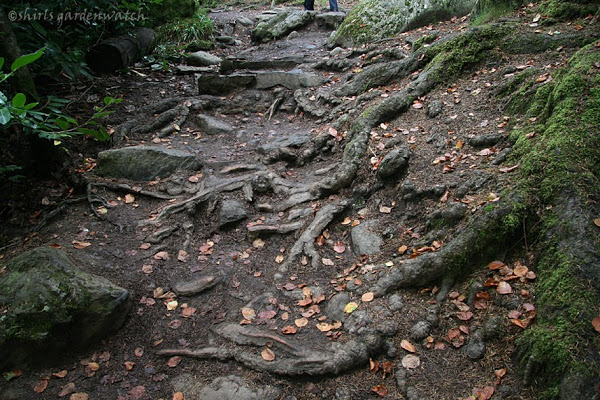
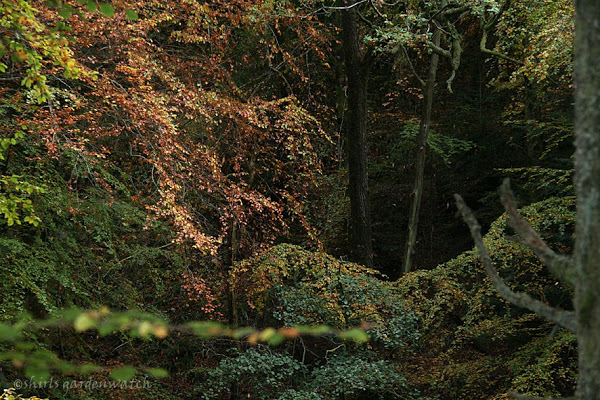
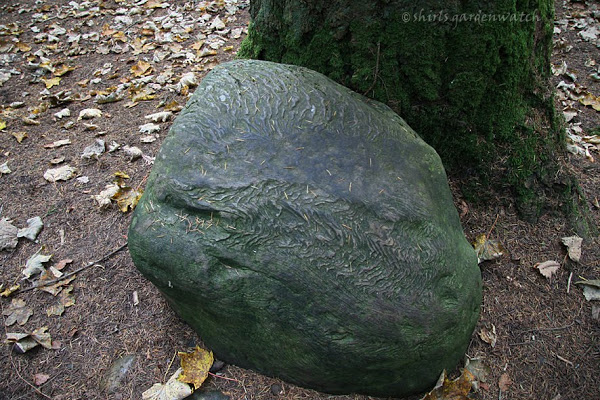
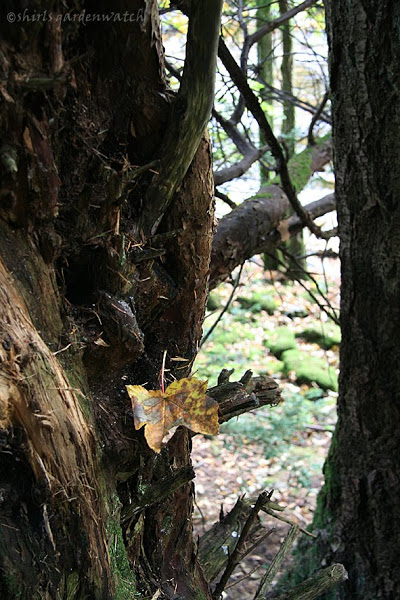
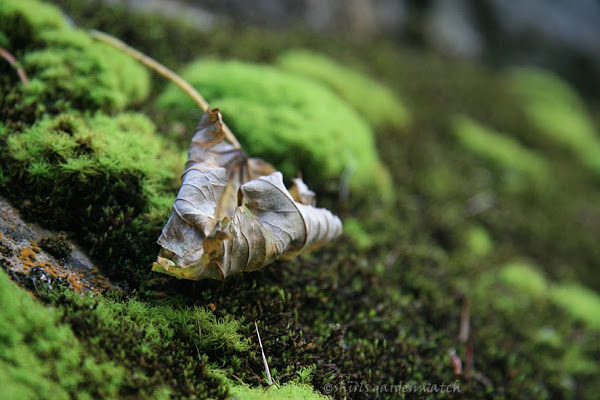
Oh dear ~ yet another worry that we need to be aware of Shirl. I have two perennial fuchsias in the garden and touch wood they seem to be ok up to now. My worry was that last winter may have seen them off as they were so late coming into growth. One of them in fact has not flowered. On a sadder note we have two mature ailing chestnut trees on the garden boundary 🙁 They have actually produced a good number of conkers this year – the squirrels are stashing them away. When we first moved here over twenty years ago, the garden was regularly visited by children looking for a good haul ~ this year not one such visitor to date!
I have a fuchsia in my window box. I don't grow them every year but they sure look pretty right now. I hope this is something that doesn't make its way over here. Do fuchsias survive your winters or do you have to bring them into a greenhouse for the winter? The photos of you walk were spectacular. I love to see your countryside. Leaves are raining down here too. I can actually hear them when I am outside or have the windows open. Happy Autumn to you too.
Oh goodness, Shirl! There is always something new to worry about 🙁 I have one perennial fuchsia in the front garden which was here when we moved in (a long time ago!) and one in a pot in the back garden which was originally in a hanging basket. As far as I know there is no problem with them but I will take a close look later.
I had heard about the Horse Chestnut trees on Autumnwatch and thought it most distressing, I can't bear to think of a time when these familiar and beautiful trees disappear from our landscape. I do hope that Nature does what she does best and overcomes this horrible threat with natural predators before it is too late!
I think I will get a cup of coffee after all that to cheer myself up, I won't shoot the messenger though 🙂
Hi again Anna, oops sorry to be the bearer of bad news here. Hope your fuchsias stay okay. Oh dear, doesn’t sound so good for your chestnut trees. Perhaps some of nature’s little helpers will bring them back to health 🙂
Hello Lisa, sounds like your fuchsias are okay. I hope they stay that way. I guess if you keep an eye on the new growth you’ll be able to spot any change.
Hands up… I don’t grow fuchsia. I’m not a fan, but fully appreciate so many gardeners are. The summer bedding type wouldn’t last outside here over winter. Definitely not in Scotland. I’m not sure they would survive in an unheated greenhouse either. I may be wrong though.
I am thrilled you enjoyed my photos. I had quite a few but only posted my favs. I know everyone will be posting autumn scenes soon. I’m sure you’re with me on the loving mosses at this time of year.
That Autumn sound of leaves falling is quite special isn’t it? Thanks, enjoy the rest of your week 😀
Hello Jan, oh dear… didn’t want to worry you either. Although, after having flatworms (and still do) I felt it was better people knew about this to help prevent it from spreading. Wind and bees can spread it too so (sorry bad news again) if your neighbours have it the chances are higher that you might see it in your fuchsias too.
Hope your fuchsias stay safe. I was hoping my photos in between the info would cheer you up just a little. Hope you’ve recovered now. Enjoy the rest of your week 😀
Dear Shirl…I love how you informed your blog friends about the fuchsia gall while showing photos of the changing season linking us to your day…so creative…
Walking along, sharing your autumn, now aware of the new threat to fuchsia …
I liked this post a lot!!
I hope that pest stays 'over the pond'. I love fuchsia but it is a demanding little plant here. I have used it in containers in the past but not this year.
We do seem to be having more and more plants being attacked by one bug or another. Horse Chestnut trees in the village here seem to have finally succumbed to leaf miners.
Hi again Brenda, thank-you 😀
I do enjoy mixing things up in a posting especially when there is a message there. Unfortunately the next post had bad news too so that got an even bigger mix up 😉
Oh dear… looking at your latest post I see you’ve had unexpected frost. I always forget how cold and long your winters can be in Nova Scotia.
Wishing you a great weekend… warm enough for gardening too 😀
Hi again Layanne, I’m guessing it hasn’t been found with you. I agree, I hope it stays that way 🙂
Never thought of the fuchsia in the terms of demanding as I don’t grow it. Wishing you a good weekend 😀
Hello John,, it does seem that way. I get regular emails from the RHS and other groups telling me of something we should know about.
I’m off the camp that like to think that natural predators can help and nature will find a balance by itself. I’m also a realist and that’s not always possible.
Sorry to hear about the Horse Chestnuts in your area. I’m sure they will be a great loss. I have heard that it is more a problem with large groups of plantings. It was suggested to me that here in Scotland we don’t have as many large plantings and that might possibly slow the problem down.
Wishing you a good weekend 😀